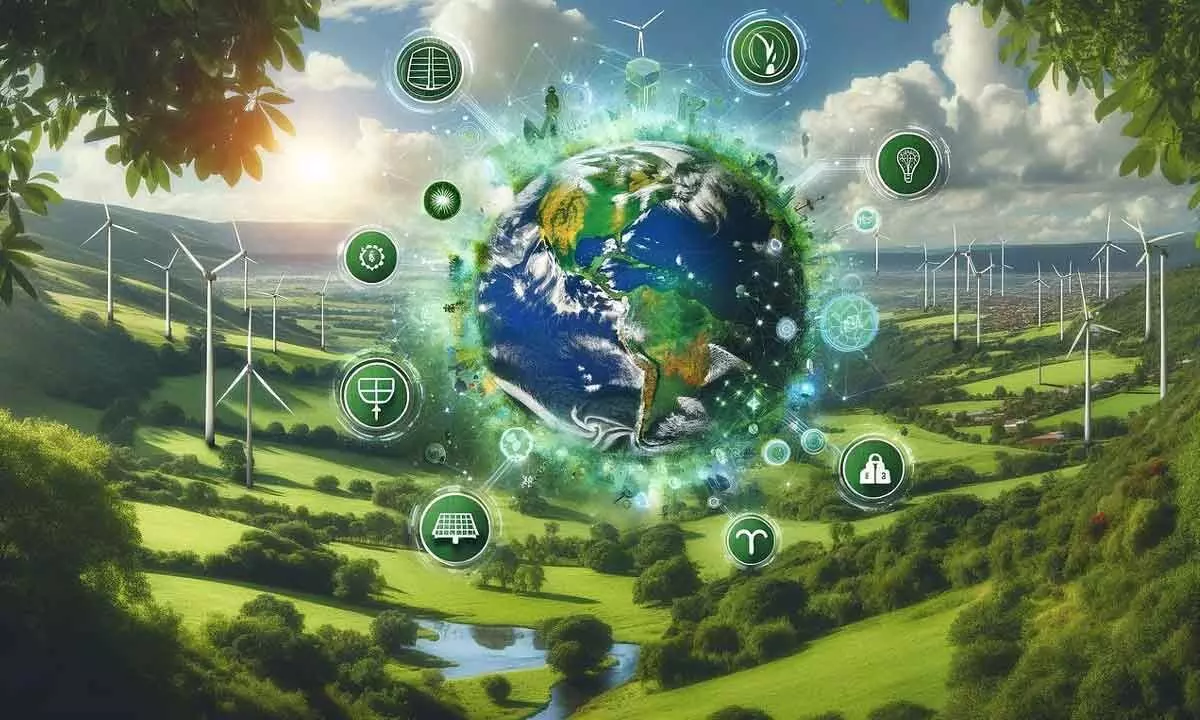Live
- NFR issues notice to 20 GCPA leaders for disrupting railway services
- Bengal school job case: CBI submits third supplementary charge sheet
- Opelka beats Mpetshi Perricard in Brisbane, reaches first final since 2022
- RJD to convene national executive meet in Patna on Jan 18
- ‘Temple’ shirt row continues in Kerala
- Rajnath Singh to present 'chadar' at Ajmer Sharif Dargah on Jan 5
- No Entry to Collectorate Without a Helmet - Collector Badavath Santosh
- Every Pregnant Woman Deserves Safe Motherhood -DMHO Dr. K.V. Swarajyalakshmi
- Human Metapneumovirus (HMPV) Surge in China: Is It Similar to Covid-19?
- Bengaluru Gears Up for Anniversary Show of Classic Motorcycles
Just In
Sustainable IT Practices: How Technology Has Contributed in 2024 to a Greener Future


Technological innovation is no longer just about what can be created but about how it can be created responsibly.
The global technology sector is at a crossroads of innovation and environmental responsibility. As digital transformation continues, the sector is redefining its role in solving climate concerns, transitioning from a major energy consumer to a potential builder for global sustainability.
The Transformative Invisible
Under the modern gadgets and slick user interfaces is a significant change in the architecture of technology. This move, according to Mr. Praveen Joshi, Managing Director of RSK Business Solutions, is a basic rethinking of technology advancement rather than a choice.
"We're no longer talking about sustainability as a peripheral concern," says Mr. Praveen Joshi, with three decades of experience. "It's now embedded in the core DNA of technological innovation."
Energy Efficiency: Not Just Buzzwords
A significant change has occurred in modern data centres. Sophisticated cooling systems, enhanced power management algorithms, and renewable energy integration have all significantly decreased carbon footprints. Machine learning now optimises energy consumption in real time, resulting in intelligent systems that adapt and reduce waste.
"The use of AI plays an important part in this transformation," Mr. Praveen continues. Energy consumption trends are analysed by complex algorithms, which find inefficiencies and provide quick solutions. These ideas have the effect of lowering energy consumption across the world's technological infrastructure.
The Circular Economy in Technology Manufacturing
The old sequential "produce, use, discard" paradigm is going out of style. Technology manufacturers are adopting extensive recycling and refurbishment operations. Modular architecture simplifies component replacement, increasing device lifespans and omitting electronic waste.
Innovative material science has resulted in biodegradable and recyclable components. Semiconductors, traditionally considered environmental hazards, are increasingly being constructed with recyclable use in mind. With this method, electronic waste is converted from a resource that might damage the environment to a probable resource.
Cloud Computing's Green Revolution
“Green cloud computing is about reimagining data centres with energy-efficient technologies like SSDs, DVFS, and AI-driven cooling systems, transforming them into hubs of sustainability while driving the digital future.” Mr. Varinder Singh Jawanda, CEO of Millennium Automation Systems Limited (MASL). Shared infrastructure means reduced individual energy consumption, with sophisticated load-balancing techniques minimizing wasted computational power.
Virtualization technologies have been instrumental in this transformation. A single physical server now hosts multiple virtual environments, dramatically reducing the hardware footprint and associated energy requirements.
Software: The Invisible Sustainability Champion
Software engineering has emerged as an unexpected hero in sustainability efforts. Developers are now integrating energy efficiency directly into code architecture. Programming languages and development frameworks increasingly include tools that measure and optimize energy consumption.
"Energy-efficient software is redefining sustainability through smarter coding and architecture. By optimizing algorithms, adopting energy-efficient programming languages, and reducing unnecessary data transfers, developers can significantly lower power consumption. Efficient architectures that minimize data exchange, optimize caching, and integrate low-power hardware further enhance energy savings. Lifecycle assessments and refactoring unused code ensure ongoing environmental benefits, making software a key driver of green innovation.," explains Mr. Jawanda.
The Human Element
Sustainability in technology isn't just about infrastructure—it's about people. Training programs are equipping technology professionals with skills in green computing, creating a new generation of environmentally conscious innovators.
Corporate cultures are shifting, with performance metrics now including environmental impact alongside traditional financial indicators. This holistic approach ensures that sustainability becomes more than a department—it becomes an organizational philosophy.
Economic Implications
The transition to sustainable IT practices is not a cost centre but an economic opportunity. Reduced energy consumption translates to significant financial savings. Companies investing in green technologies are seeing improved operational efficiency and enhanced market reputation.
Venture capital is increasingly flowing into technologies that promise both environmental and economic returns. This financial ecosystem is accelerating innovation, creating a positive feedback loop of sustainable technological development.
The Road Ahead
The journey towards truly sustainable technology is ongoing. Challenges remain, but the momentum is undeniable. Technological innovation is no longer just about what can be created but about how it can be created responsibly.
Mr Jawanda concludes, "The road ahead for sustainability in IT lies in harmonizing innovation with responsibility, embracing energy-efficient software, green data centres, and AI-driven optimizations, while aligning every digital advance with measurable environmental impact."
The technology sector has transformed from a potential environmental challenge to a critical part of the global sustainability solution. Each innovation, each line of code, and each design choice now carries the potential to reshape our environmental future.

© 2024 Hyderabad Media House Limited/The Hans India. All rights reserved. Powered by hocalwire.com






